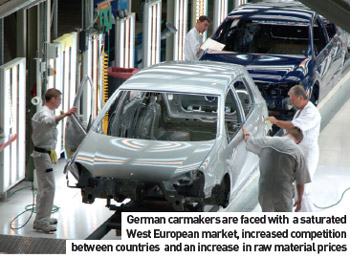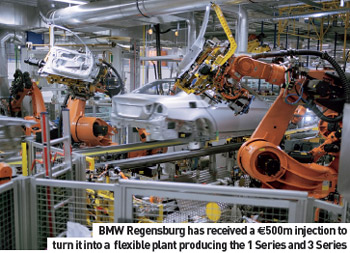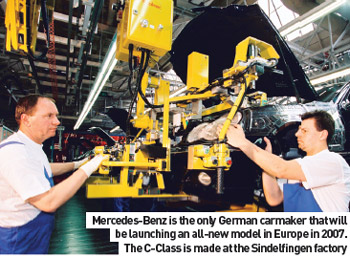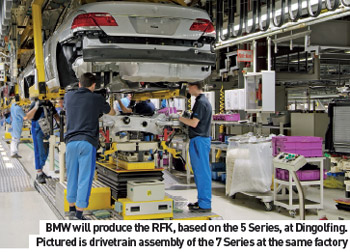Germany has always been an attractive region for car manufacturers because of its central location in the heart of Europe, and access to a pool of skilled labour. But competition from low-cost regions has led to a rethink in strategy
Given its relatively high cost structure, Germany’s attractiveness as an automotive production location is regularly called into question. Volkswagen spent most of 2006 in a battle with unions to reduce the costs of a major restructuring programme, and Opel has been making considerable cuts across the board, while at the same time, investing heavily in low-cost countries, such as Poland. In defiance of its critics, however, Germany remains the heart of the European automotive industry, and vehicle and component production continues to grow.
This year and 2008 are expected bring further restructuring challenges at vehicle manufacturers and suppliers, who will need to retain a tight rein on costs to maintain competitive with low-cost countries. Furthermore, the industry is facing a new threat that appears to be moving quickly up the agenda. Climate change and the need to reduce CO2 emissions from transport are moving centre stage, and legislation is appearing at local, national and regional level. German manufacturers of high-polluting premium vehicles can be expected to hit hardest.
Passenger car production in Germany reached 5.4 million units in 2006, a slight increase on the previous year but, nevertheless, a new peak level. The share of vehicles exported reached a new all-time high of 72 per cent, proving that Germany remains a competitive location from which to export, mostly to the rest of Western Europe.
Data from the German automotive industry trade association, VDA, turnover in the German automotive industry is increasing but employment is falling, suggesting that productivity is improving.
High production growth is not expected in Germany for 2007, largely because of German carmakers’ model cycles. Only one new model, the Mercedes-Benz C-Class, will be launched there during the year, although other key models will be face-lifted and ranges will extended.
This coincides with a peak of new model activity at other vehicle manufacturers. According to CSM Worldwide European Vehicle Forecasts, 70 new vehicles will be launched across Europe. As a result German vehicle production could fall slightly in 2007. Opinions vary. The IKB (investment bank) forecast that carmaking in Germany will fall by one per cent in 2007, because of this effect. Polk Marketing Systems also forecast a small decrease. However, a recent statement by the VDA suggests that because of strong underlying demand in the domestic German market, it is expecting German production to increase slightly.
Positive or negative, whatever happens, 2007 will not be a strong growth year.
Longer-term, however, significant growth is forecast. Thomas Mawick, an analyst with Polk Marketing Systems, argues that recent agreements between management and workers in German plants have led to new cost structures which will allow Germany to remain competitive overseas.
A direct result of this is that VW, which persuaded its workers to return to a 35-hour week from a 28.8 hour week with no extra pay, has decided to concentrate production of its Golf model at two German plants – Wolfsburg and Mosel (Sachsen). The Golf was previously also built in Belgium. According to Polk Marketing Systems, the Golf is not the only model that will strengthen Germany’s position.
Four new SUVs will be made in Germany in the next few years. These are the VW Tiguan (Wolfsburg), Audi Q5 (Ingolstadt), Mercedes-Benz GLK (Bremen), and an SUV based on the Ford Focus (Saarlouis).
Another growing segment for German plants is the crossover segment. VW will build a coupé based on the Passat (Emden), while BMW will build the RFK, based on the 5 Series, possibly at Dingolfing. Other new models to be made in the next three years are Porsche’s Panamera (Leipzig), Audi’s A5 coupe (based on the A4 platform), and a wider range of BMW 1 Series variants. These won’t be nett additions to existing volume as they will cannibalise sales of existing models, but they will make German manufacturers less dependent on exports, according to Mawick. Seventy two per cent of passenger cars produced in Germany were exported – just 1.6 million were sold on the domestic market.
A total of 3.9 million vehicles were exported in 2006, an increase of 2.5 per cent on a year earlier. In announcing its year-end data, the VDA’s President Dr Bernd Gottschalk noted that the statistics prove that Germany is still a competitive automotive production location, even when German manufacturers are increasing production overseas.
Overseas production was up by 13 per cent in 2006. The share of exports has been growing and is expected to increase, which will fuel overall production. Polk Marketing Systems forecasts that by 2010, German car production will reach 5.7 million units.
Challenges facing the German car industry
All this optimism relies on the German automotive industry remaining focused on key challenges. According to Siegried Roth of the German metalworkers’ union IG Metall, the sector faces seven major challenges:
- Increasing competition (from both technology and costs)
- Saturated west European markets
- Radical change in the demand structure with fleet purchases becoming less important and growing demand for small cars. Some of this can be linked to future CO2 emissions requirements
- Growing cost pressure on suppliers
- Increasing raw material prices
- Increasing competition between countries and regions to attract investment
- Investment and capacity increase in emerging markets and low cost countries.
BMW has been growing year-on-year and 2006 was no exception. By 2010 the company plans to deliver 1.6 million vehicles. Indeed, a previously set retail sales target of 1.4 million vehicles, set for 2008, will be met a year ahead of schedule. The carmaker has four plants in Germany. The largest is Dingolfing, which produces more than 1,200 cars a day (5, 6 and 7 Series models). Regensburg, which celebrated its 20th anniversary in October last year, has had a €500m injection since 2002, to turn it into a flexible plant.
 The 1 Series and 3 Series are produced there, although BMW recently said the three-door version of the 1 Series, which has been launched almost three years later than the original five-door version, will be produced in Leipzig. The 3 Series is also produced in Munich and Leipzig.
The 1 Series and 3 Series are produced there, although BMW recently said the three-door version of the 1 Series, which has been launched almost three years later than the original five-door version, will be produced in Leipzig. The 3 Series is also produced in Munich and Leipzig.
Apart from the introduction of the three-door 1 Series, there are no major product actions planned at BMW that will affect German production this year. In 2008, an important new model will enter production in Germany.
BMW is refusing to call the model an MPV because that does not fit in with its brand image, so it is called a ‘space-functional concept’ (code-named with the German acronym RFK). It is also referred to internally as LSC – luxury sports coupé. It is essentially BMW’s interpretation of a people carrier. That car is expected to be derived from both the 5 Series and the X5, and will be built in Germany, although BMW has not yet confirmed at which plant. As it shares components with the 5 Series, Dingolfing would appear to be the likely place.
Another crossover, which BMW refers to as a sports activity vehicle (SAV) coupé, but is also referred to in media reports as the X6 or X coupe, will not be produced in Germany. BMW has already announced that it will go into production in Spartanburg in America early in 2008. New derivatives of the 1 Series are planned – a coupé (late 2007) and a cabriolet (early 2008), as well as a roadster (mid- 2008) and a Touring model (early 2009), and these could be built in Leipzig or Regensburg.
BMW is expected to be hardest hit by CO2 legislation. The carmaker is currently only targeting a 140g CO2/km corporate average, and will need to rely heavily on hybrid technology to bring CO2 emissions down to the 120g CO2/km limit by 2012.
Mercedes-Benz sales showed a decrease in 2004 and 2005, but this trend was reversed in 2006, when sales hit an all-time high of 1,148,500 cars, up seven per cent on the previous year’s figures. DaimlerChrysler has three car plants in Germany – Rastatt produces the A-Class and new BClass.
The C-Class is produced at Bremen and Sindelfingen. Bremen also produces the CLK, while the CL, E-Class, SClass and Maybach are produced in Sindelfingen.
The latest generation C-Class was launched on January 18, 2006 and is the first major car model to have been developed within Mercedes Car Group’s CORE cost reduction programme. CORE has a specific goal of improving return on sales (ROS) by seven per cent in 2007.
Manufacturing is integral to the CORE programme. In addition to reducing fixed costs and optimising assets, DaimlerChrysler is moving to a module strategy and increasing production efficiency. All Mercedes assembly lines are being optimised with the introduction of standardised processes for plant efficient optimisation (‘Standardbegehung’) and the company is focusing on reducing hours per vehicle (HPV) as a lever for improving production efficiency.
According to Rainer Schmückle, COO of Mercedes Car Group, the ‘Standardbegehung’ process creates ideas that allow HPV targets to be reached using intense interdisciplinary cooperation of all functions. In 2006, Mercedes Car Group achieved a 10 per cent reduction in HPV, and in the medium term, it plans to reduce this by a further 30 per cent. These moves are also designed to improve quality (there were a few problems in the past, and there are signs that warranty costs are falling as a result).
DaimlerChrysler has already been hit by the shift to smaller vehicle segments because of high oil prices. A less favourable model mix was one of the factors behind a decline in earnings during the year. Longer-term new the restructuring of smart will help bring DaimlerChrysler’s average CO2 emissions per vehicle sold down. All smart cars are currently produced in France. Major new models for Germany are a new E-Class from the beginning of 2009.
A planned small SUV (possibly named GLK or MLK) due at the end of 2008 and based on the C-Class, is also a candidate for German production.
Although the VDA figures show that supplier employment fell in 2005 compared to a year earlier, the longer-term trend is that supplier employment has been increasing. This can be attributed to the fact that carmakers are outsourcing more work.
A study, FAST 2015, by Mercer Consulting, is frequently quoted in Germany. It shows that suppliers will contribute 77 per cent to the value-added or a European vehicle by 2015, compared to 65 per cent in 2020. This translates to 280 billion Euros in additional business for suppliers each year. The biggest growth will be in the electrical and electronics segment, in which German suppliers are traditionally strong.
The study forecasts that the number of Tier 1 suppliers will be halved during the same period to 2,800 companies. Many Tier 1 suppliers have their headquarters in Germany, and this trend can be expected to benefit the regional supplier industry overall.
According to investment bank IKB, the German supplier industry is growing at about nine per cent a year. In 2005 that fi gure slowed to six per cent because of high raw material prices, but in 2006 is thought to have recovered again to around eight per cent.
It was a year of turmoil for VW in 2006, highlighted by complex labour negotiations and a tumultuous change of management at the end of the year. The company sold 5.73 million vehicles worldwide, an increase of 9.3 per cent on 2005 figures.
A major hurdle in VW’s restructuring efforts has been overcome, with the agreement that workers at its main Wolfsburg site return to a five-day working week (up from four days). This move is of major significance to the German automotive industry. Golf production at the site was threatened if productivity was not improved.
The carmaker will produce all next-generation Golfs in Germany, at Wolfsburg and Mosel. Previously, some were produced in Belgium.
VW has seven plants in Germany, none of which produces anything smaller than the Golf. The Passat is produced at Wolfsburg, Emden and Mosel, vans are produced in Hannover, while the newest plant, in Dresden, is dedicated to assembly of the VW Phaeton and some Bentley Continental Flying Spurs. Wolfsburg also produces the Touran. The two remaining sites are the Audi plants at Neckarsulm (A6, A8) and Ingolstadt (A3, A4). VW produces smaller models in Spain and Eastern Europe, and Audi’s planned new small car, dubbed A1, will go into production in Belgium from 2009.
VW Group will introduce several new models in Germany in the next few years. Audi will build the new A5 coupe and Q5 SUV in Germany, while VW will add the Passat coupe to production at Emden and its new small SUV, the Tiguan to production at Wolfsburg. The Tiguan will be in the Auto 5000 subsidiary that also produces the Touran. VW has an agreement that all-new models can be produced within this separate company that has different payment and working terms from the rest of the company.
Although VW has improved efficiency at Wolfsburg, it wants to cut 20,000 jobs in total, and by the end of 2006, just 7,800 jobs had gone. The next target for job cuts is likely to be component operations. Reinhard Jung, VW Board Director for Production and Logistics, has stated that in-house operations costs should be reduced by €1.3 billion by 2008, and productivity should grow at six per cent a year. VW’s main component operations in Braunschweig, Salzgitter and Kassel assemble engines, axles, clutches, clutch components and exhaust parts. Wolfsburg-based Sitech Sitztechnik employs 2,000 people to make seats in Wolfsburg, Emden, Polkowice in Poland and Shanghai. Furthermore, VW employs 1,300 in its Hannover foundry.
Group CEO Martin Winterkorn is expected to continue cost-cutting programmes put in place by his predecessor. As regards manufacturing, in the medium term he is likely to intensify shared use of platforms, engines and modules across the Group that could see Audi plants brought into the VW Group production network more closely.
Ford guarantees German production
Ford has two plants in Germany – Cologne, where the Fiesta and Fusion are made, and Saarlouis where it makes the Focus and C-Max. Over 400,000 units were produced in 2006, down from 423,000 a year earlier. Production at Cologne reached a new record level of 412,800 units in 2006 following the launch of an all-new Fiesta in 2005. The Fiesta and Focus are also made in Spain at Ford’s Valencia plant.
In March 2006 Ford reached an agreement with its German workers to secure assembly at the two plants for the next five years. The Ford Fiesta and Fusion will continue to built at Cologne and the Focus at Saarlouis in exchange for wage rates moving closer to the national automotive industry ‘tariff,’ Ford said in a statement at the time.
Previously, employees were paid above the national tariff.
Ford also reaffirmed its policy of avoiding compulsory workforce redundancies, although it did seek voluntary redundancies during the year. The agreement affects all 24,000 Ford-Werke employees. There are 18,000 Ford- Werke employees in Cologne, including the Merkenich technical development centre and parts depot; a further 6,400 are in Saarlouis.
Ford will produce a Focus-based SUV in Saarlouis from 2008. Although production is only guaranteed until 2010, unlike GM, Ford has plants in Eastern Europe over to which it can switch production.
GM – Bochum and Ruesselsheim struggle to compete General Motors has three plants in Germany – Bochum (Astra and Zafira), Eisenach (Corsa), and Ruesselsheim (Vectra). Eisenach will benefit from the introduction of a new Corsa last year, but production is shared with Zaragoza in Spain. In January it built its 2,000,000th car.
Unlike Eisenach, however, which was built in the former East Germany to develop lean production and still operates at a higher level of efficiency than many other plants, the other two German plants are not considered to be globally competitive. Indeed, production of the Astra and the Vectra is being cut this year as the new Corsa cannibalises sales of the older Astra and customers move away from traditional D Segment models like the Vectra, to similar models from upscale brands such as BMW and Audi.
 The debate about where the next generation Astra (due in 2010) will be built continues with GM saying only that it needs just three European plants to produce the car, rather than the current four. These are at Bochum, Antwerp (Belgium), Ellesmere Port (UK), and Gliwice (Poland). Combined production at those plants is currently 1.1 million vehicles, but reports suggest that GM is only expecting to need about 750,000 units capacity in Europe for the next generation model. Poland is clearly the lowest cost plant of the four, and unions at the other plants have closed ranks to ensure that they are not played off against one another to win the production contracts. Any of them could lose production of the Astra.
The debate about where the next generation Astra (due in 2010) will be built continues with GM saying only that it needs just three European plants to produce the car, rather than the current four. These are at Bochum, Antwerp (Belgium), Ellesmere Port (UK), and Gliwice (Poland). Combined production at those plants is currently 1.1 million vehicles, but reports suggest that GM is only expecting to need about 750,000 units capacity in Europe for the next generation model. Poland is clearly the lowest cost plant of the four, and unions at the other plants have closed ranks to ensure that they are not played off against one another to win the production contracts. Any of them could lose production of the Astra.
At the end of 2006 GM signed an agreement with unions safeguarding existing production and promising not to transfer production of existing models from Western European plants until 2012 but it has added the Zafira to assembly in Poland, threatening volumes at Bochum.
Rüsselsheim’s future as an assembly plant is entirely dependent on the Vectra, although it has been suggested that flexibility at the plant is so high, thanks to recent investments, that it could also be in the running to produce the Astra. A new Vectra is due at the end of 2008. Vectra production was about 140,000 units in 2006 but is expected to fall to around 120,000 in the current production year.
One way to reduce the impact of reduced Astra production would be to build models for other GM brands on the same platform.
A Saab 9-1 and/or a similar Cadillac model are possibilities. Porsche adds a fourth model No analysis of the industry can be complete without mention of Porsche. Porsche is a success story – a niche carmaker that produces more than 100,000 premium-priced vehicles a year, returning the highest margins in the industry.
Porsche has the obvious benefit of a high-value brand which commands premium pricing, but it is also a manufacturing success story, largely because it has the highest level of outsourcing in the industry. For example, just 10 per cent of the value-added of the Porsche Cayenne SUV, assembled at Porsche Leipzig, is made in-house.
Not all Porsche assembly is in Germany. The Boxster and Cayman models are assembled by Valmet in Finland, but Porsche is adding a fourth model, the Panamera, to its offering; it will be made at Leipzig from late 2008.
Porsche is the largest shareholder in the Volkswagen Group, and is seeking to increase its influence, but this is not likely to have a major impact on manufacturing, other than it might help if Porsche is part of a larger group when it comes to meeting future CO2 requirements. Manufacturers will increasingly be relying on small models to bring their corporate average down – Porsche does not have smallengined, low-polluting models.




































